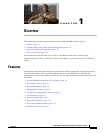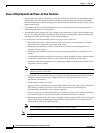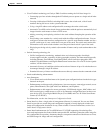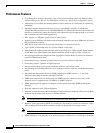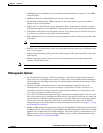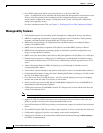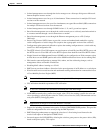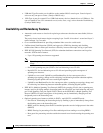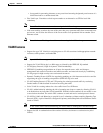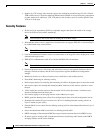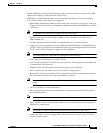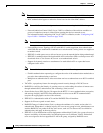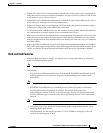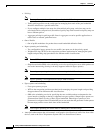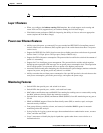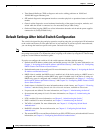
1-9
Catalyst 2960 and 2960-S Switch Software Configuration Guide
OL-8603-09
Chapter 1 Overview
Features
–
Loop guard for preventing alternate or root ports from becoming designated ports because of a
failure that leads to a unidirectional link
• Flex Link Layer 2 interfaces to back up one another as an alternative to STP for basic link
redundancy
Note To use Flex Links, the switch must be running the LAN Base image.
• Link-state tracking to mirror the state of the ports that carry upstream traffic from connected hosts
and servers, and to allow the failover of the server traffic to an operational link on another Cisco
Ethernet switch.
Note To use Link-state Tracking, the switch must be running the LAN Base image.
VLAN Features
• Support for up to 255 VLANs for assigning users to VLANs associated with appropriate network
resources, traffic patterns, and bandwidth
Note Up to 64 VLANs are supported when the switch is running the LAN Lite image.
• Support for VLAN IDs in the 1 to 4094 range as allowed by the IEEE 802.1Q standard
• VLAN Query Protocol (VQP) for dynamic VLAN membership
• IEEE 802.1Q trunking encapsulation on all ports for network moves, adds, and changes;
management and control of broadcast and multicast traffic; and network security by establishing
VLAN groups for high-security users and network resources
• Dynamic Trunking Protocol (DTP) for negotiating trunking on a link between two devices and for
negotiating the type of trunking encapsulation (IEEE 802.1Q) to be used
• VLAN Trunking Protocol (VTP) and VTP pruning for reducing network traffic by restricting
flooded traffic to links destined for stations receiving the traffic
• Voice VLAN for creating subnets for voice traffic from Cisco IP Phones
• VLAN 1 minimization for reducing the risk of spanning-tree loops or storms by allowing VLAN 1
to be disabled on any individual VLAN trunk link. With this feature enabled, no user traffic is sent
or received on the trunk. The switch CPU continues to send and receive control protocol frames.
• VLAN Flex Link Load Balancing to provide Layer 2 redundancy without requiring Spanning Tree
Protocol (STP). A pair of interfaces configured as primary and backup links can load balance traffic
based on VLAN.
Note To use VLAN Flex Link Load Balancing, the switch must be running the LAN Base image.
• Support for 802.1x authentication with restricted VLANs (also known as authentication failed
VLANs)



